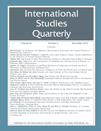
Choosing Your Neighbors: Networks of Diffusion in International Relations
Type
In examining the diffusion of social and political phenomena like regime transition, conflict, and policy change, scholars routinely make choices about how proximity is defined and which neighbors should be considered more important than others. Since each specification offers an alternative view of the networks through which diffusion can take place, one’s decision can exert a significant influence on the magnitude and scope of estimated diffusion effects. This problem is widely recognized, but is rarely the subject of direct analysis. In international relations research, connectivity choices are usually ad hoc, driven more by data availability than by theoretically informed decision criteria. We take a closer look at the assumptions behind these choices, and propose a more systematic method to asses the structural similarity of two or more alternative networks, and select one that most plausibly relates theory to empirics. We apply this method to the spread of democratic regime change, and offer an illustrative example of how neighbor choices might impact predictions and inferences in the case of the 2011 Arab Spring.

